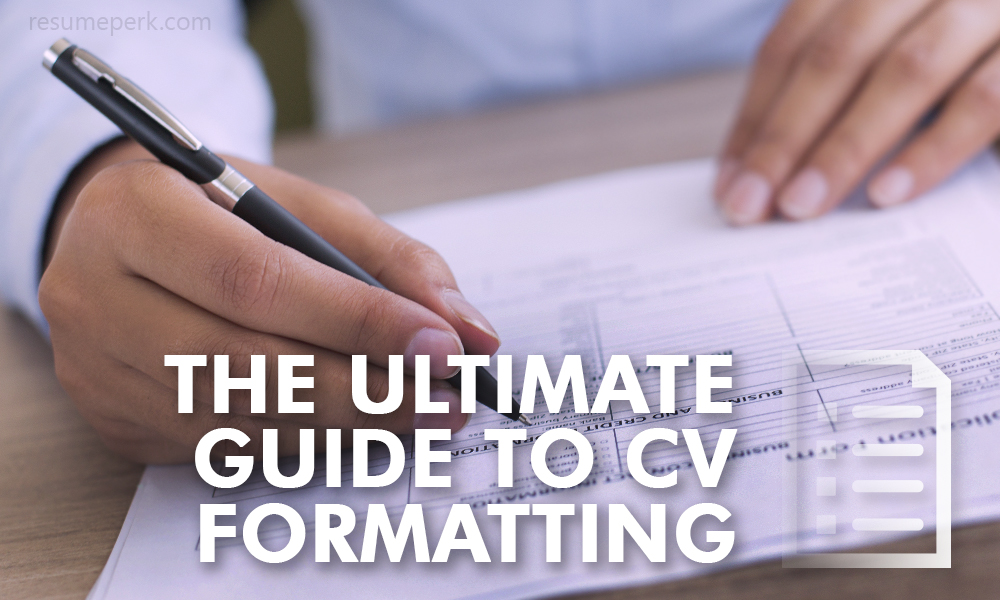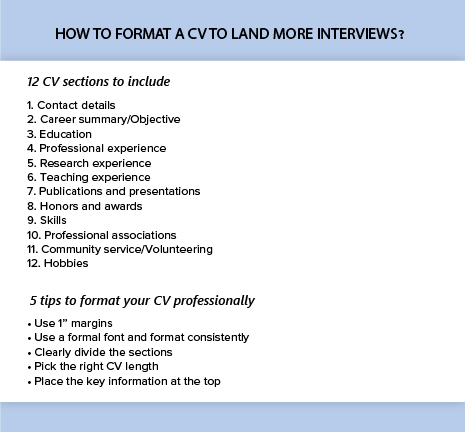How to Format A CV to Get More Interviews?
 A CV formatting is one of the small things that make a big difference to the success of your CV. A neat, logically correct and clear structure increases the chance that your CV will be read through. But use wrong or cluttered format, and all your stellar accomplishments might be overlooked.
A CV formatting is one of the small things that make a big difference to the success of your CV. A neat, logically correct and clear structure increases the chance that your CV will be read through. But use wrong or cluttered format, and all your stellar accomplishments might be overlooked.
Although the final content of your CV will depend on the role you’re aiming to apply for, there’s a basic order of sections in a CV that you should follow. Using the classic CV structure makes it scannable for the recruiters and ensures that all your information is placed correctly. Today, a resume writer NYC will guide you through the process of formatting your CV to the best standards.
Note that this article is specifically focused on writing a CV, or curriculum vitae. CVs are used to apply for British, German and most European jobs and for academic positions within the US. If you seek guidance on how to write a resume, read here: https://resumeperk.com/blog/how-to-write-a-chronological-resume-7-simple-steps.
Receive professional assistance with curriculum vitae writing format
Have you written a CV but would like to hear a professional opinion about its format and contents? Then, a resume expert from Resumeperk.com team can help. Send us your written resume and receive detailed feedback about its quality free of charge. You’ll also get professional advice and tips on what to revise and improve in your resume. And for those job-seekers who are in a hurry we offer urgent resume writing and editing help – receive a custom professionally done resume in 24 hours only.
12 simple steps for a perfect format of a CV
Basically, the main reason why you want to work on formatting is to organize your work history in a way that appeals most to recruiters and hiring managers. Additionally, a correct and neat layout does something more that breaks your long CV into easy-to-read sections: it communicates such important personality traits as attention to detail and ability to structure information.
What is the format of a CV?
The phrase ‘CV format’ stands for the way your resume content is organized, from the sections you decide to include and their order to the font, indents and formatting tricks. The structure of your CV can be flexible depending on your career goal, but to ensure your CV gets maximum visibility, we recommend that you include the following sections as listed below.

12 CV categories to include
- Contact information
Although there’s a common practice to put work and home phone numbers, marital status, date of birth and other similar information in a European CV, it isn’t necessary. A sufficient contact data is a cell number, email and a city of residence. Keeping contact section this short will save the CV space and show your ability to prioritize the information. - Objective or career summary
This section serves as an elevator pitch and introduces you to the reader. It is meant to summarize your key competencies, professional or research interests and the value you can bring to the company or research organization. To get the most out of this section, keep it between 3-5 sentences and focus on the absolutely important facts that can’t be found anywhere else on a CV. For in-depth guidance on summary section writing, check this out: https://resumeperk.com/blog/how-to-write-a-resume-summary-statement-10-examples. - Education
The education section gets more exposure on a CV than it does on a resume. List all your academic degrees starting with the most advanced one. In addition to school name, major and graduation date include the relevant coursework, academic accomplishments (such as Dean’s or President’s list) and any other important details pertaining to your educational background. - H3: Professional experience
Professional experience is the obligatory and probably the most important section of your CV, so be sure to invest a decent amount of time to make it perfect. List your relevant work experience, including company name, role and a brief description of each one. Job responsibilities and accomplishments should be given in the form of a bulleted list, starting with a strong action verb. Be strategic about what to include and try not to go beyond 7-8 bullet points for each position you had. - Research experience
This section is aimed to specifically highlight your capabilities as a researcher. Include any laboratory or hands-on research experience, with the detailed description of the project, the research outcomes and your responsibilities. Also, include the name of professors or scientists you collaborated with and indicate whether there was a publication in a journal. - Teaching experience
For those professionals aiming at academic positions in college or a university, this section is a must. To give your teaching background maximum exposure, list the school name, class name, semester and a brief description of your duties and accomplishments. No teaching experience yet? List any supervisory, group leadership and tutoring experience you have. - Publications, presentations and conferences
Another section designed specifically for academic CVs – skip it if you are writing a professional CV. List all book, journal and website publications you’ve authored or co-authored, including the work currently in progress. Be sure to add bibliography details in a relevant citation style. Mention the presentations you’ve delivered with conference/organization name and date.
This section, along with your research and teaching experience, is a real asset of any academic CV – the longer they are, the more qualified of a candidate you’ll be considered. - Honors and awards
All your academic, professional awards, scholarships and any other kinds of professional or academic recognition belong here. This is your chance to brag as a highly-accomplished and in-demand professional.
Feeling stuck and exhausted with your CV writing? Learn our pro secrets of creativity increasing. - Skills
Professional skills are important since they serve as keywords and help the reader quickly assume your strengths without reading the entire CV. So, list your most job-relevant and competitive skills in this section (no less than 10 skills). If you have a skill-based job (a programmer, financial analyst, etc.), you might want to divide your extensive set of skills into specific subsections, such as Programming languages, Frameworks, Professional software, Soft skills, etc. - Professional associations
If you’re a member of any professional organization, list these organization in this section. If you are a board member, include your title and areas of responsibility. Don’t belong to any professional affiliation? Research some of them and wonder how you can become a member. This will not only add value to your CV, but also can expand your career opportunities. - Community service and volunteering
All clubs, volunteering activities and other types of community service also deserve being mentioned on a CV. If you’re a participant, listing the organization’s name and your role will be enough. If you hold a leadership position, though, be sure to give the description of your role in 2-3 sentences. - Hobbies
A seemingly minor section, it is aimed to give your professional CV a touch of personality. It also might help to make a personal connection with the hiring decision-maker. The key secret here is to be specific and strategic: ‘cooking and dancing’ won’t make any difference to your CV whereas ‘classical music, running marathons, and the Far East traveling’ might.
Have you included all the necessary sections? No time to relax – you’re only halfway through the completion of a strong CV that will set you apart from other candidates.
Formats of CVs: 5 tips to give your CV a final touch
Once you’ve given your CV a proper reverse chronological structure, it’s time to work on its formatting to make the document easy to read and skim through. Here are the five major steps you can follow to make a huge difference to the visual appearance of your CV:
- Set the margins to 1’’
One of the most important rules when it comes to composing your CV is using white space efficiently. Setting all margins to 1’’ helps your document look neat. If you use larger margins, the CV will turn out unnecessarily long as you’ll need more pages to fit all your important content. Small margins, in their turn, create an impression that your pages are overloaded with text and hard to read. - Use formal font and format consistently
Opt for a modern yet professional font such as Arial, Calibri or Tahoma. For the convenience of the person reading your resume, keep the font size between 10 and 12 pts. Use boldface, italic and all-caps strategically to highlight the most important CV details (such as section headers, position/company names). - Divide the sections clearly
Contrarily to a resume, CV doesn’t assume fancy and bright formatting. However, is absolutely should be easy to navigate through. One of the best ways to structure the information for the reader is to use big and clear section headings (Professional Experience, Publications, etc.). - Use the appropriate CV length
How long should a CV be? If you are puzzling over this, here’s the answer. A professional CV should be no longer than 2-3 pages in length. However, an academic CV can be as long as you need to place all your publications, relevant experience and more. In the US, a CV that has 10+ pages isn’t rare. - Place the information strategically
For a successful CV, it’s important not only what you decide to include but also where you include it. To make sure the key facts from your career biography get noticed by the reader, place the most important information at the top and on the left side of the first page. That’s how the hiring managers naturally look through the resume, so the crucial details won’t escape their attention.
By giving your CV an appropriate structure and using the above tips for effective formatting, you’ll significantly increase the chances of your CV to be picked for an interview. So, it’s time to decide on what to wear on an interview to make a brilliant impression on the company representative.
Don’t know how to format a curriculum vitae? Our expert can help
Do you feel that your CV somewhat undersells you or don’t know how to adapt it for your target job to get noticed? Say no more. Proficient resumes writing experts of our company can take your CV to the next level, highlighting your key strengths for the job and downplaying any shortcomings. All work is done by resume copywriters and copyeditors with at least 2 years of experience. Professionals of Resumeperk com can create you a CV from scratch as well as edit, revise and proofread your existing one. And the pay will pleasantly surprise you – due to high demand, we keep our prices one of the lowest in the market. A limited 20% discount offer is available – contact our online assistant to learn more.
Recommended reading:
- Top Killer Questions to Ask at the End of an Interview Process | ResumePerk
- 10 Signs That the Job Interview Went Well
- Ace Your Zoom Interview With These 19 Tips | ResumePerk
- HR Manager Interview Questions & How to Answer Them | ResumePerk
- 11 Questions To Ask Before Accepting A Job Offer
- 20 Important Tips For Successful Job Interview
